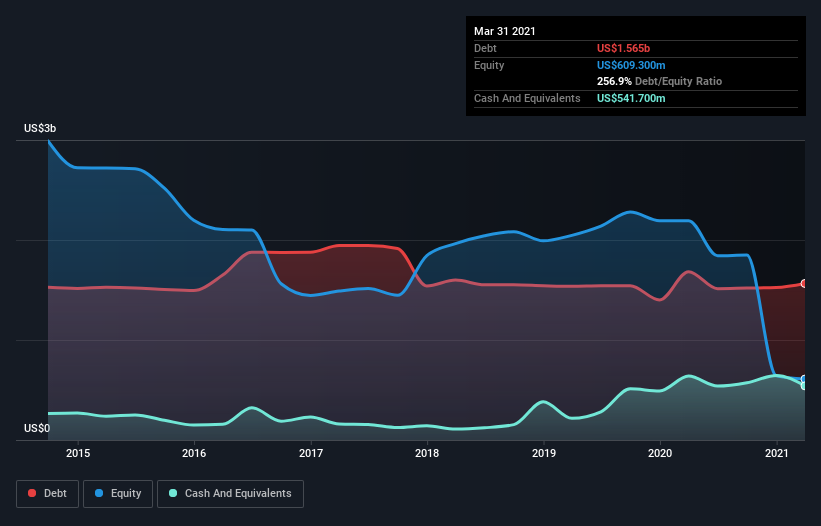- United States
- /
- Aerospace & Defense
- /
- NYSE:ATI
Allegheny Technologies (NYSE:ATI) Has A Somewhat Strained Balance Sheet
Legendary fund manager Li Lu (who Charlie Munger backed) once said, 'The biggest investment risk is not the volatility of prices, but whether you will suffer a permanent loss of capital.' So it might be obvious that you need to consider debt, when you think about how risky any given stock is, because too much debt can sink a company. We note that Allegheny Technologies Incorporated (NYSE:ATI) does have debt on its balance sheet. But the more important question is: how much risk is that debt creating?
When Is Debt Dangerous?
Debt is a tool to help businesses grow, but if a business is incapable of paying off its lenders, then it exists at their mercy. In the worst case scenario, a company can go bankrupt if it cannot pay its creditors. While that is not too common, we often do see indebted companies permanently diluting shareholders because lenders force them to raise capital at a distressed price. Of course, plenty of companies use debt to fund growth, without any negative consequences. When we examine debt levels, we first consider both cash and debt levels, together.
Check out our latest analysis for Allegheny Technologies
How Much Debt Does Allegheny Technologies Carry?
The image below, which you can click on for greater detail, shows that Allegheny Technologies had debt of US$1.53b at the end of March 2021, a reduction from US$1.68b over a year. On the flip side, it has US$541.7m in cash leading to net debt of about US$990.3m.

How Strong Is Allegheny Technologies' Balance Sheet?
The latest balance sheet data shows that Allegheny Technologies had liabilities of US$689.2m due within a year, and liabilities of US$2.77b falling due after that. On the other hand, it had cash of US$541.7m and US$465.9m worth of receivables due within a year. So its liabilities outweigh the sum of its cash and (near-term) receivables by US$2.45b.
This is a mountain of leverage relative to its market capitalization of US$2.61b. This suggests shareholders would be heavily diluted if the company needed to shore up its balance sheet in a hurry.
In order to size up a company's debt relative to its earnings, we calculate its net debt divided by its earnings before interest, tax, depreciation, and amortization (EBITDA) and its earnings before interest and tax (EBIT) divided by its interest expense (its interest cover). This way, we consider both the absolute quantum of the debt, as well as the interest rates paid on it.
Allegheny Technologies shareholders face the double whammy of a high net debt to EBITDA ratio (7.1), and fairly weak interest coverage, since EBIT is just 0.15 times the interest expense. The debt burden here is substantial. Worse, Allegheny Technologies's EBIT was down 96% over the last year. If earnings keep going like that over the long term, it has a snowball's chance in hell of paying off that debt. There's no doubt that we learn most about debt from the balance sheet. But it is future earnings, more than anything, that will determine Allegheny Technologies's ability to maintain a healthy balance sheet going forward. So if you're focused on the future you can check out this free report showing analyst profit forecasts.
Finally, while the tax-man may adore accounting profits, lenders only accept cold hard cash. So we always check how much of that EBIT is translated into free cash flow. During the last three years, Allegheny Technologies produced sturdy free cash flow equating to 54% of its EBIT, about what we'd expect. This free cash flow puts the company in a good position to pay down debt, when appropriate.
Our View
To be frank both Allegheny Technologies's interest cover and its track record of (not) growing its EBIT make us rather uncomfortable with its debt levels. But at least it's pretty decent at converting EBIT to free cash flow; that's encouraging. We're quite clear that we consider Allegheny Technologies to be really rather risky, as a result of its balance sheet health. For this reason we're pretty cautious about the stock, and we think shareholders should keep a close eye on its liquidity. Given the risks around Allegheny Technologies's use of debt, the sensible thing to do is to check if insiders have been unloading the stock.
If, after all that, you're more interested in a fast growing company with a rock-solid balance sheet, then check out our list of net cash growth stocks without delay.
If you decide to trade Allegheny Technologies, use the lowest-cost* platform that is rated #1 Overall by Barron’s, Interactive Brokers. Trade stocks, options, futures, forex, bonds and funds on 135 markets, all from a single integrated account. Promoted
New: Manage All Your Stock Portfolios in One Place
We've created the ultimate portfolio companion for stock investors, and it's free.
• Connect an unlimited number of Portfolios and see your total in one currency
• Be alerted to new Warning Signs or Risks via email or mobile
• Track the Fair Value of your stocks
This article by Simply Wall St is general in nature. It does not constitute a recommendation to buy or sell any stock, and does not take account of your objectives, or your financial situation. We aim to bring you long-term focused analysis driven by fundamental data. Note that our analysis may not factor in the latest price-sensitive company announcements or qualitative material. Simply Wall St has no position in any stocks mentioned.
*Interactive Brokers Rated Lowest Cost Broker by StockBrokers.com Annual Online Review 2020
Have feedback on this article? Concerned about the content? Get in touch with us directly. Alternatively, email editorial-team (at) simplywallst.com.
About NYSE:ATI
ATI
Produces and sells specialty materials and complex components worldwide.
Proven track record with adequate balance sheet.
Similar Companies
Market Insights
Community Narratives



